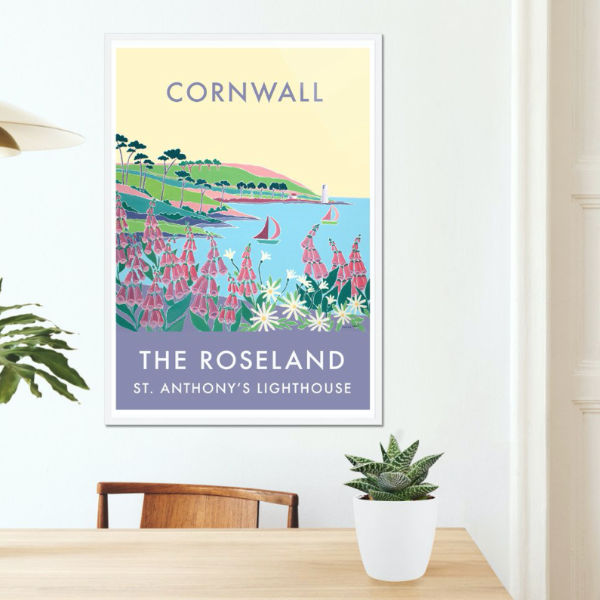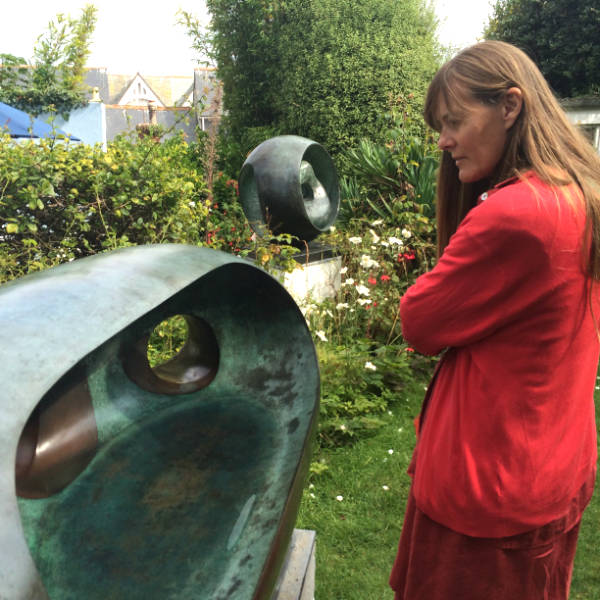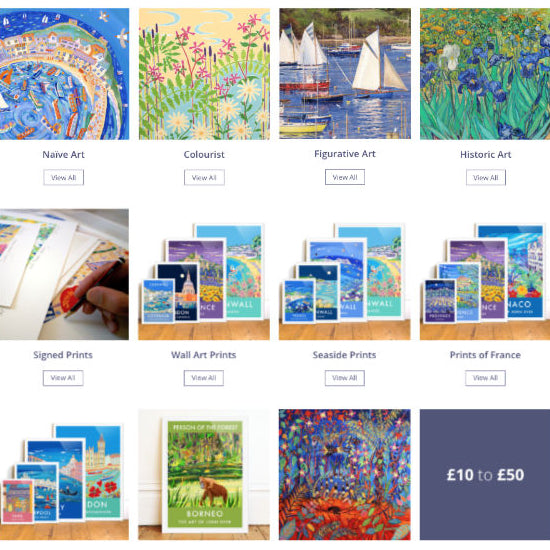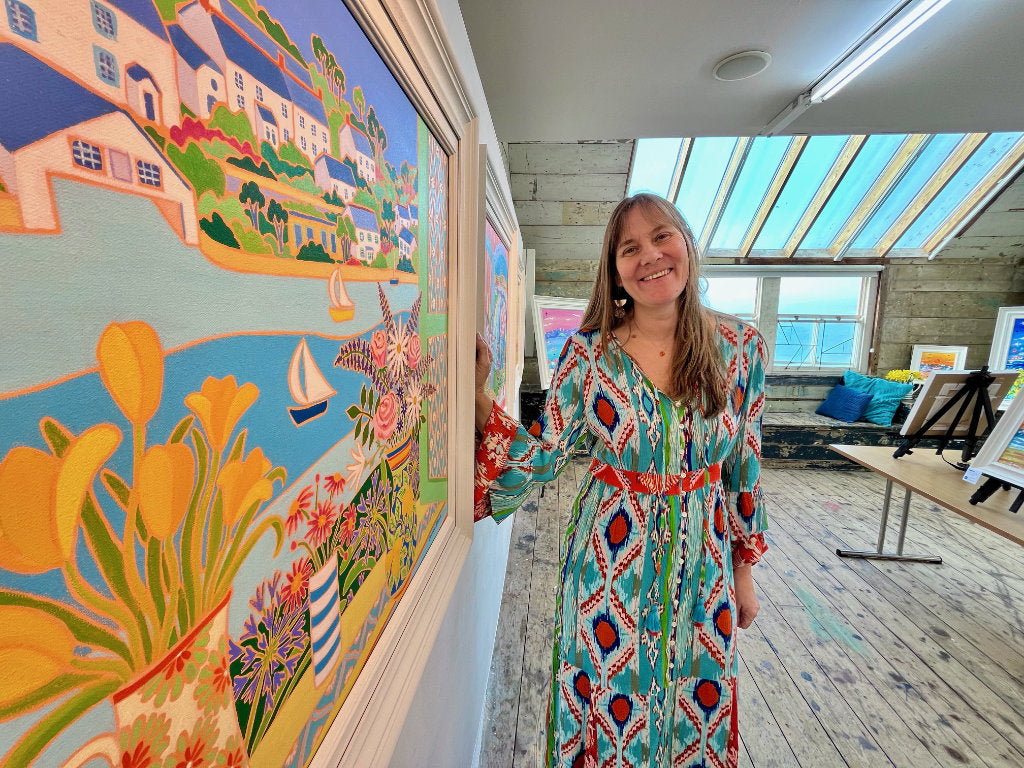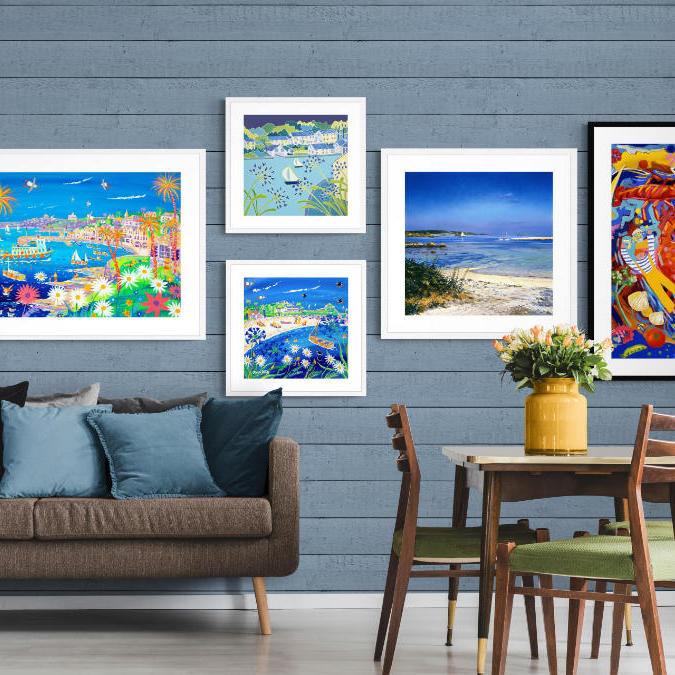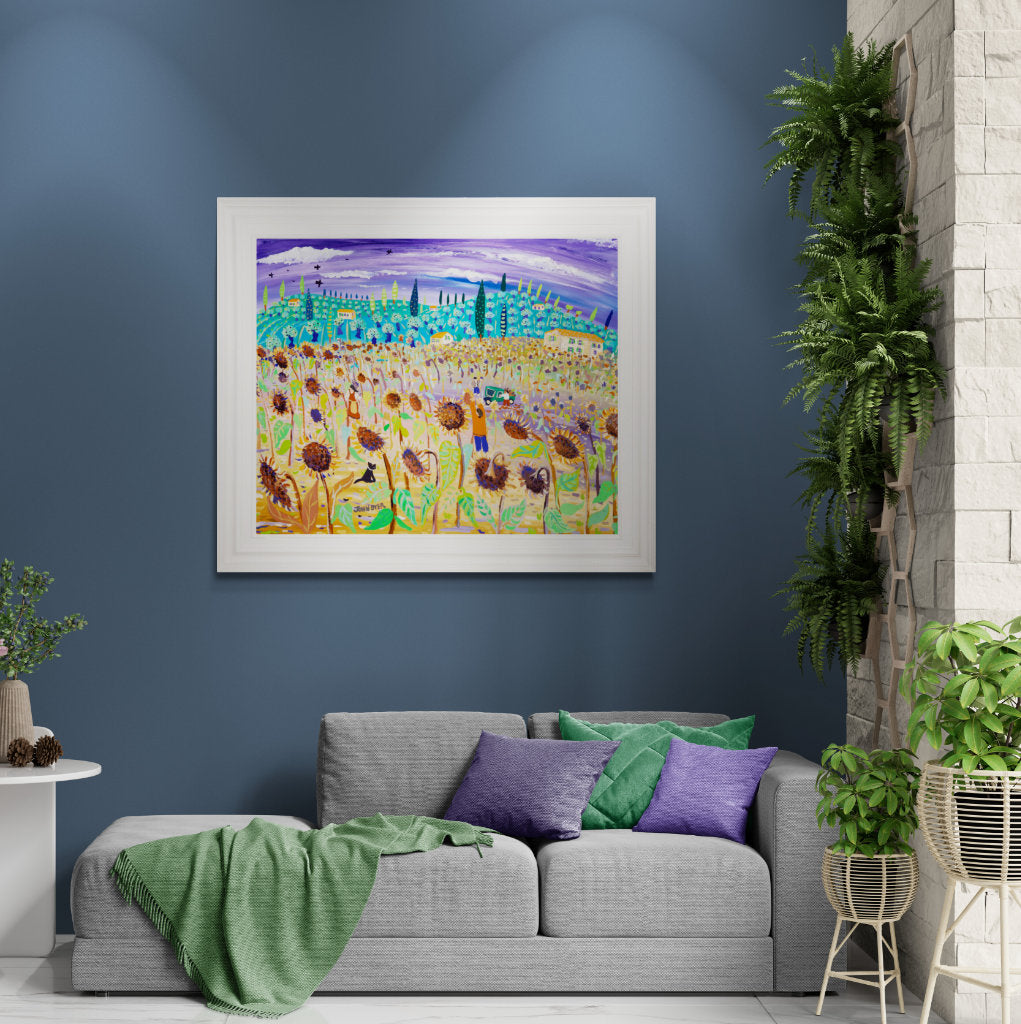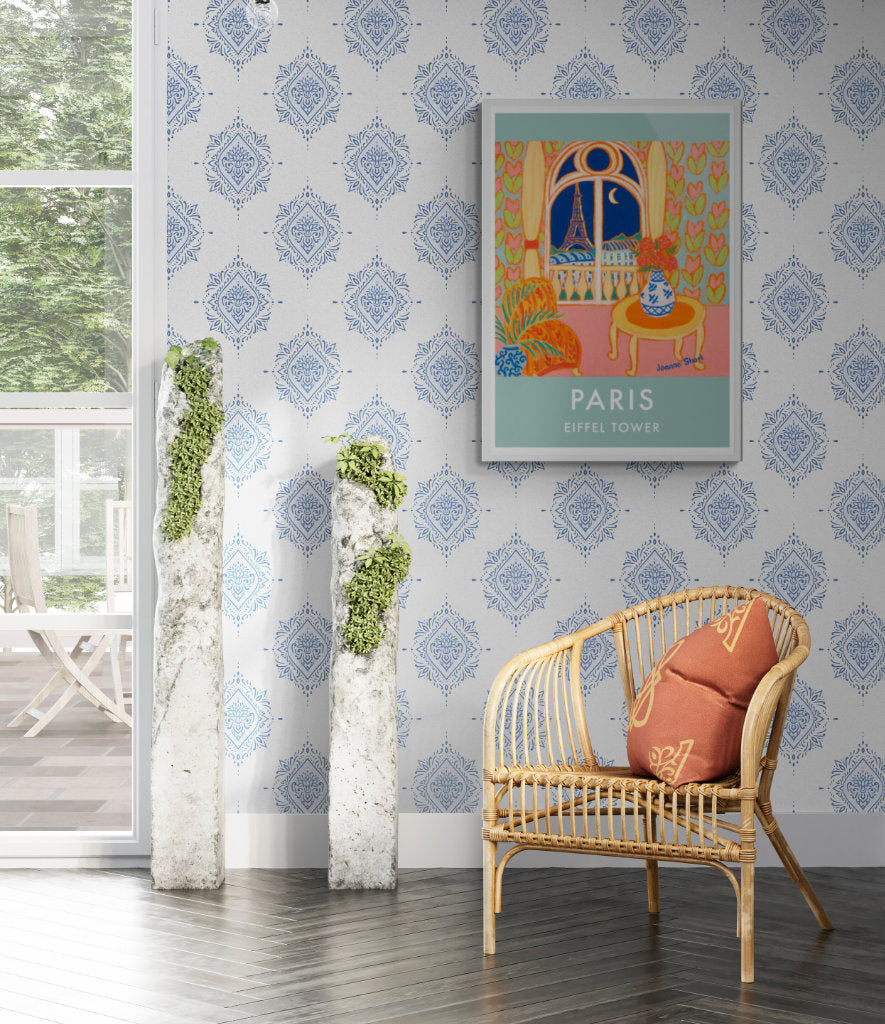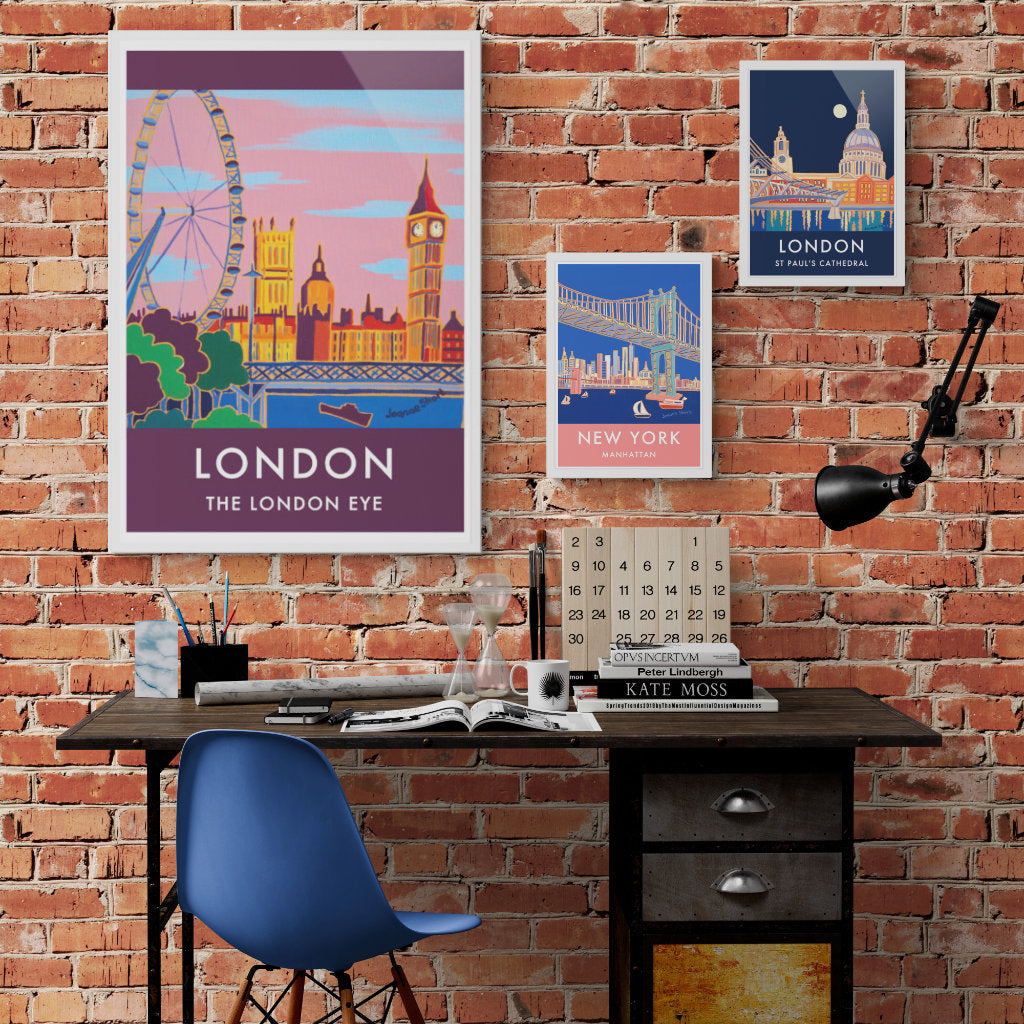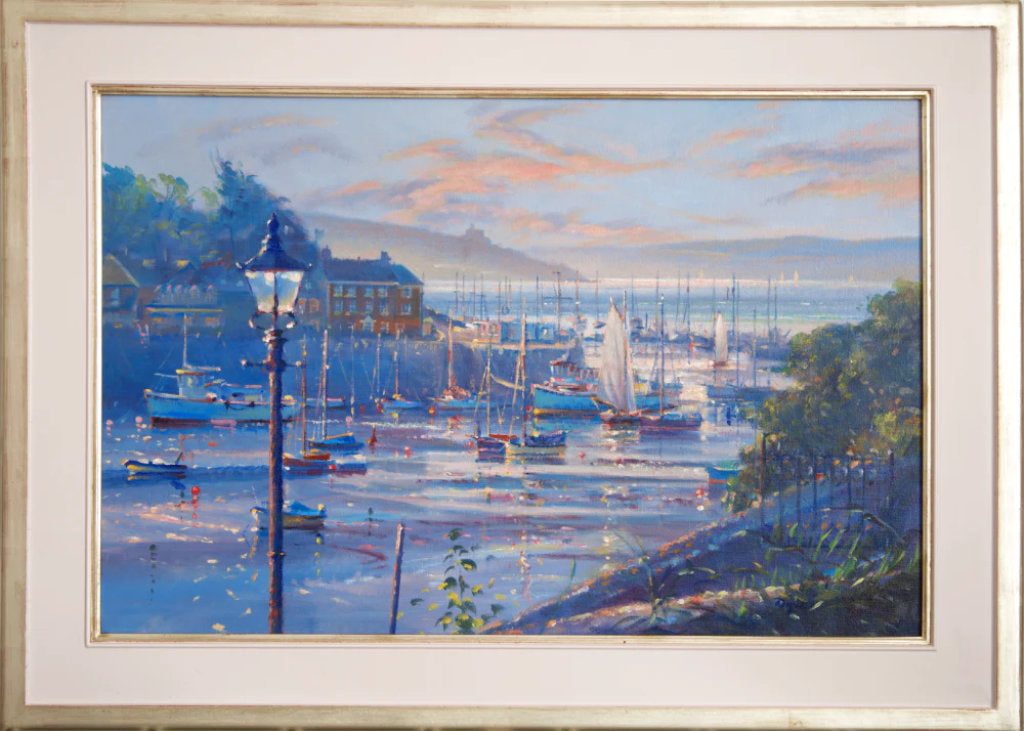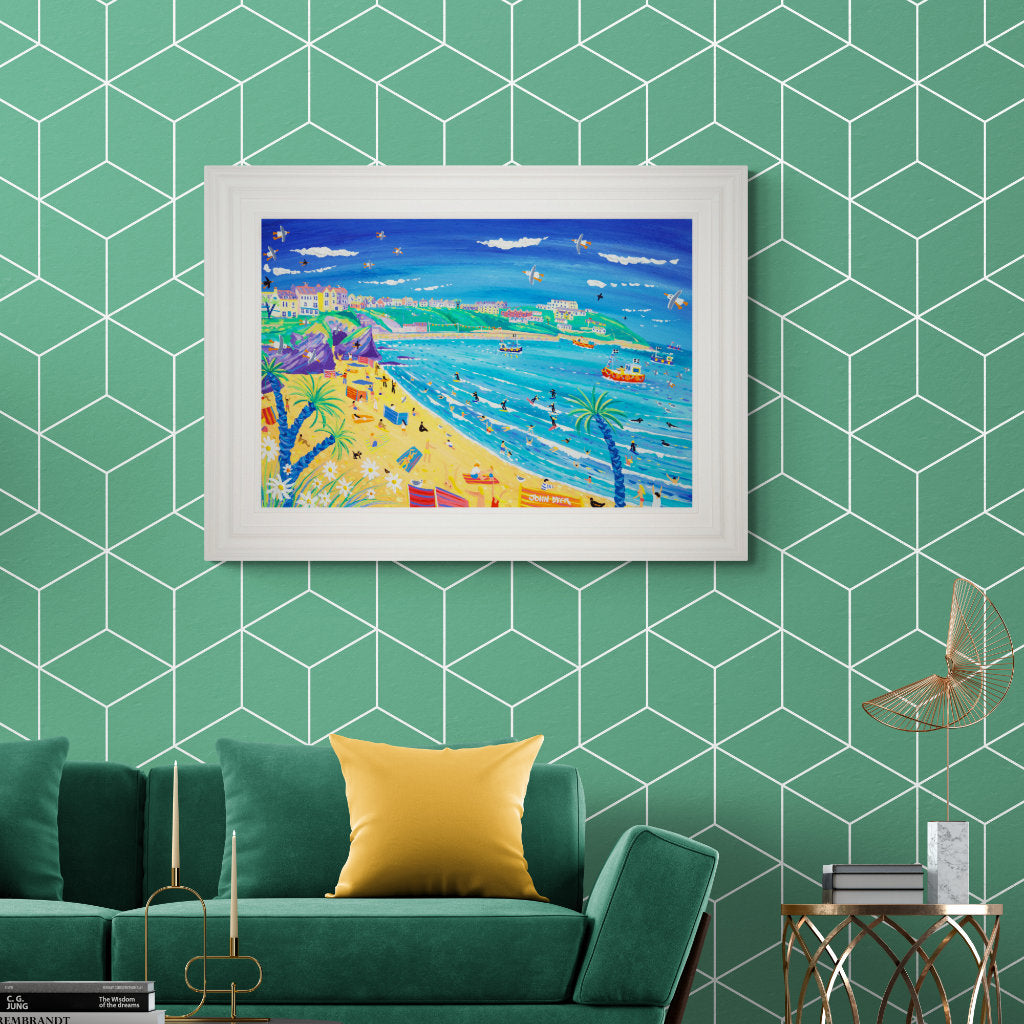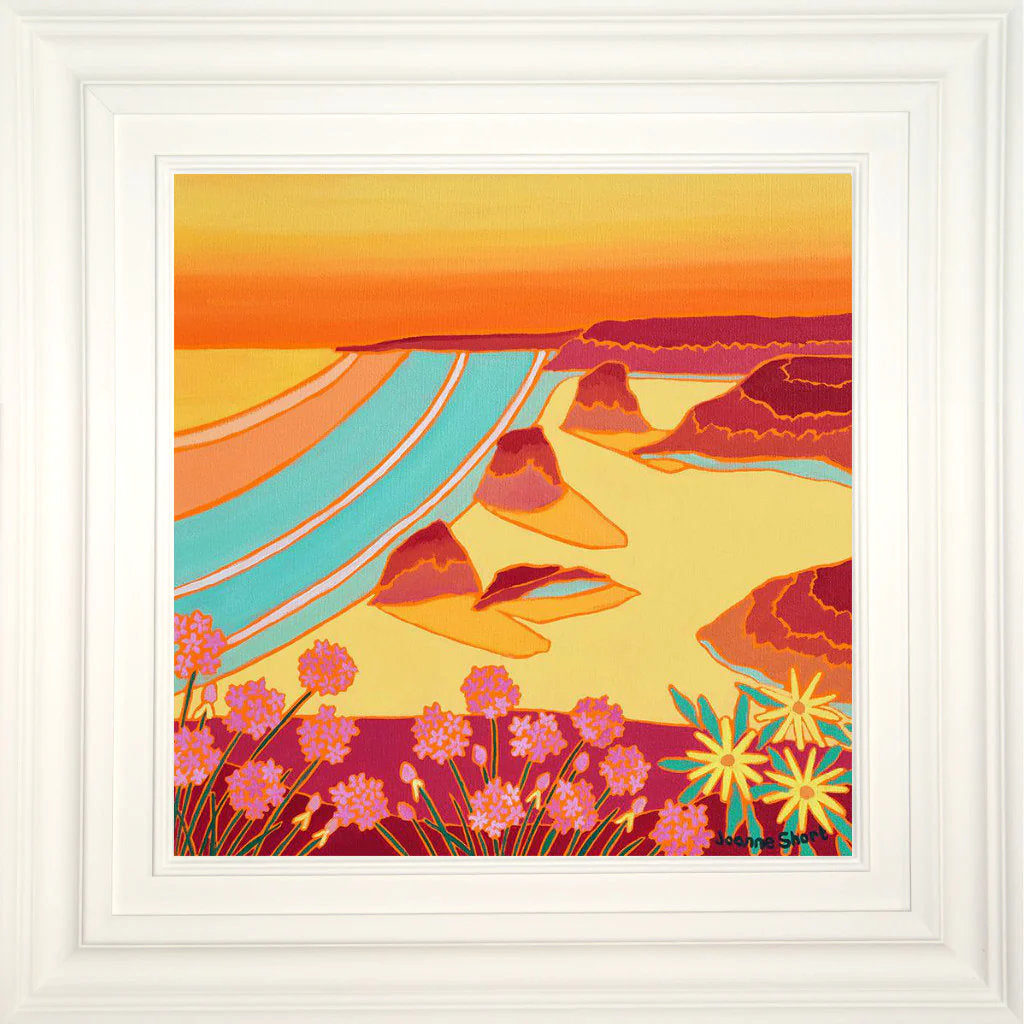
Above: An example of a bold contemporary art print that brings nature back into a contemporary interior. Sunflower wall art by Joanne Short.
Revamping your home’s style can be both thrilling and daunting. Where do you start, and what are the best approaches for a fresh, new look? Our article offers actionable ideas to decorate your home, empowering you to transform your space with simplicity and flair. From incorporating nature to playing with patterns and lighting, these tips will ignite your creativity and help you carve out an interior that’s both functional and a true reflection of your personality. Revitalise your house with paintings, prints and posters from The John Dyer Gallery - read on to see how wall art can enhance your home.
Buy Art to Improve Your Decor Online
Above: Paintings from the John Dyer Gallery by John Dyer, Joanne Short and Ted Dyer
Key Takeaways
-
Enhance your living spaces by incorporating nature into your decor through indoor plants and natural materials, and by creating striking focal points and personalised art arrangements.
-
Maximise functionality and increase the comfort of your home by utilising multi-functional furniture, seasonally updating colours and textiles to enhance your paintings, and engaging in DIY projects for unique, embellishments.
-
Strategically use patterns, textures, and colours to add depth and visual interest to each room, choosing quality pieces and timeless decor that reflects your personal style while maintaining a balance between form and function.
Incorporate Nature into Your Decor
Above: Original Painting of the Sunflower Harvest in Tuscany, Italy. by John Dyer. 'Sun Dried Faces'
With the ever-present dominance of concrete in modern architecture, infusing nature into your decor serves as a private sanctuary. The magic begins with indoor plants, adding life and colour to your spaces. Imagine a living wall in your living room, a vertical garden of thriving plants, a testament to your green thumb and a conversation starter for your guests. Not only do these houseplants purify the air, they also weave a connection to nature into the fabric of your home, especially in high-use areas like the living room and bedroom. Try introducing a painting with plants and flowers.
Above: Harvesting in Harmony with wildlife, Meru
Yet, the incorporation of nature extends beyond indoor plants. Delve deeper into the realm of natural materials. Raw woods and natural fibres like cotton and linen can transform your home decor into an organic, calming retreat, a sanctuary from the bustle of the outside world. Your love for nature can also be expressed through:
-
artworks that capture its serenity and beauty
-
original paintings and art prints that introduce the vibrancy of the natural world indoors
-
botanical prints on bed linen or wallpaper that infuse rooms with the energy of the outdoors.
Create a Focal Point in Each Room
Above: John Dyer Painting 'Gardening and Growing. Kim Wilde's garden' as a focal point to a room
The secret to engaging living rooms is to establish a focal point that instantly grabs attention. This could be a distinctive window, a fireplace, or, even better, an art piece that anchors the arrangement of the furniture. A room can house multiple focal points, such as wood ceiling beams and stone mantels, adding complexity and interest to the space. Furniture can be arranged around these natural anchors, creating an environment that is dynamic yet cohesive.
An impactful method of creating a focal point involves:
-
Setting up a gallery wall of art, ideally on a wall that is instantly noticeable upon entering a room
-
Creating a feature wall with design elements like shiplap or bold wallpaper that can immediately draw attention and set the tone of the room
-
Using statement furniture pieces that can serve as focal points without adding clutter, offering both practical and decorative benefits.
In bedrooms, starting with a standout fabric for drapes or a headboard can serve as the main visual draw and can be complemented by other textiles to enhance the focal point.
Play with Patterns and Textures
Home decor isn’t simply about choosing the right furniture or lighting. It’s also about the play of patterns and textures that add depth and interest to your space. This can be achieved by mixing different scales of patterns and incorporating unique textures into your decor. To help you achieve this, consider some home decorating tips that focus on the use of patterns and textures.
Let’s explore these two aspects in greater detail.
Mixing Patterns
Mixing and matching patterns in home decor is more about creating a visually pleasing ‘happy clashing’ rather than following strict rules. The key to a well-balanced design is to mix patterned areas with solid, plain spaces, allowing each pattern to stand out without overpowering the space. A cohesive colour palette can help in mixing patterns, with at least five colours providing contrast and harmony, and with one fabric integrating all colours together.
Above: Room set with patterned wallpaper with a print of Paris by Joanne Short
Begin with the hardest item to match, such as a rug, and build the rest of the decorative scheme around its patterns. Balance the use of busy patterned wallpaper by painting the other walls in neutral colours to prevent a cluttered appearance.
Incorporating Textures
Textures contribute a multi-layered, enriched appearance to your home’s visual charm. This can be achieved by incorporating a variety of textiles such as:
-
leather
-
velvet
-
silk
-
cotton
through rugs, window treatments, throw pillows and blankets, complemented by textured wall finishes or wallpaper.
Combining different materials and finishes—like shiny lacquered surfaces with matte accents or integrating soft furnishings with original architectural features—adds depth and contrast to your decor, a technique often used by an interior designer in designing a powder room.
Items like a wicker storage basket serve a dual purpose by adding texture and providing seasonal storage, ensuring living spaces remain uncluttered and visually attractive.
Optimise Your Lighting
Creating a balanced lighting scheme plays a vital role in home decoration. This can be achieved by layering ambient and accent lighting to accommodate various activities and enhance the space’s aesthetics. Layered lighting allows rooms to have multipurpose functions, like being a work area in the daytime and transforming into an elegant space for night-time entertaining.
Careful selection of light fixtures is crucial to complement the home’s general style, with thoughtful consideration of the height of ceilings, the scale of the room, and maintaining a well balanced look based on design elements like lines and finishes. Specific areas such as dining rooms and kitchens benefit from targeted lighting strategies such as central lighting over tables to create a focal point and task lighting that enhances functionality and aesthetics in ‘zones’. Investing in controls for easy switching and dimming, along with effects such as track lighting and wall-mounted lights, enhances lighting customisation and helps save space while providing the required illumination.
You can even invest in spotlights to pick out your favourite artworks.
Maximise Small Spaces
Small spaces present an ideal opportunity for creativity in home decor. Multi-functional furniture pieces, such as a table that transitions from a small desk to a full dining table, can optimise space utilisation. Transformable furniture like sofa beds and foldable kitchen tables provide dual purposes like sleeping and working while maintaining a small footprint when not in use.
Vertical storage solutions are key to maximising small spaces. High shelves installed close to the ceiling offer versatile storage options. Additional living areas or storage can be positioned overhead in homes with high ceilings using various loft solutions.
Incorporating elements like upright paintings in narrow spaces will always brighten up a small space. Built-in storage above or under sinks enhances vertical storage and keeps essential items within reach.
Above: Original Still Life Painting by Joanne Short. Yellow Sunflowers and Blue Tablecloth
Experiment with Colour
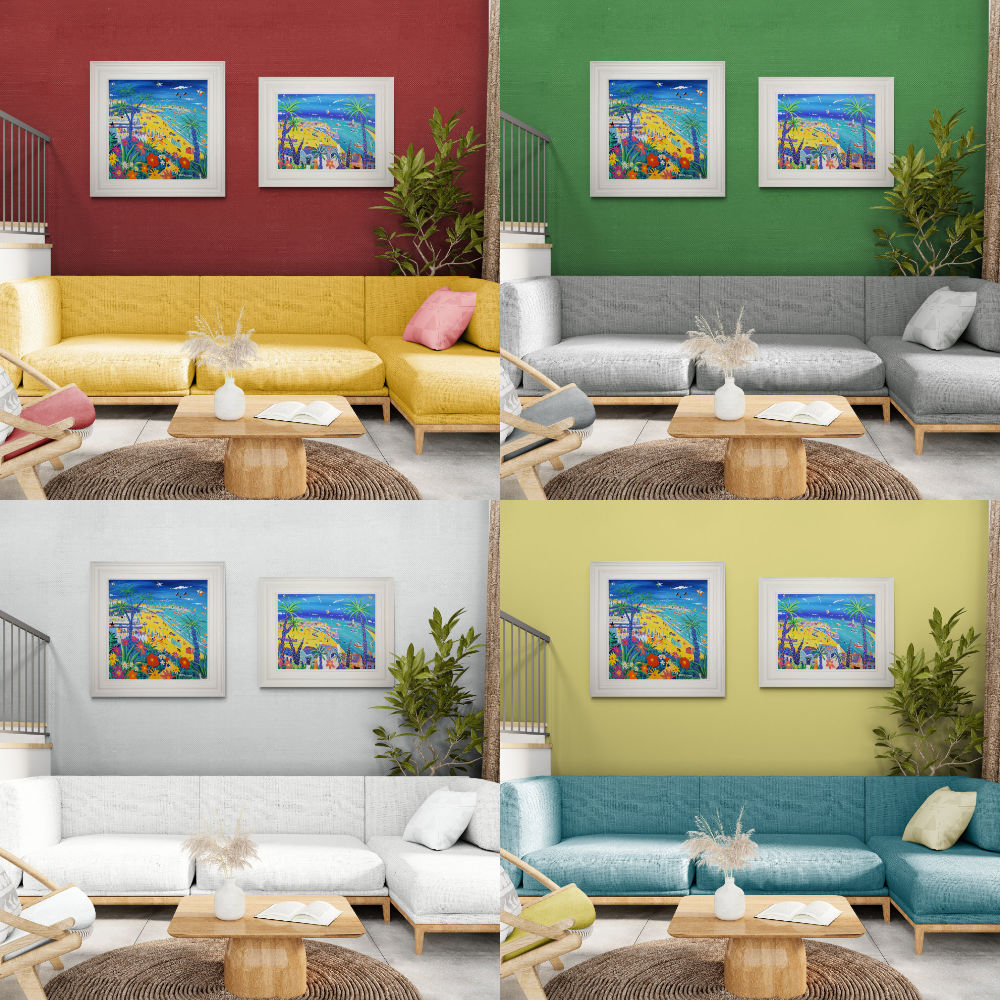
Above: Examples of how different colours effect the feel of a room. Paintings by John Dyer
Colour has the power to transform a space, evoke emotions, and reflect your personality. Experimenting with colour in your home decor is an exciting and liberating process. Each colour carries its own unique energy with it:
-
Orange is associated with happiness
-
Green brings a calming effect
-
Blue promotes tranquillity
-
Pink signifies warmth
-
Black embodies simplicity and elegance
-
Grey conveys formality
Maintaining a cohesive feel in your home is essential. This can be achieved by:
-
Using consistent colours on the walls of connecting spaces
-
Considering sightlines to ensure colours in view from one room to another work well together
-
Employing the 60-30-10 rule for colour balance, with 60% main colour, 30% accent colour, and 10% for art and accessories.
You can also introduce pastel hues like baby blue, light peach, or lavender to reflect the spring season, and infuse personality into a space with vibrant textiles in distinct colours and patterns that resonate with your style preferences.
Choose Artwork That Reflects Your Style
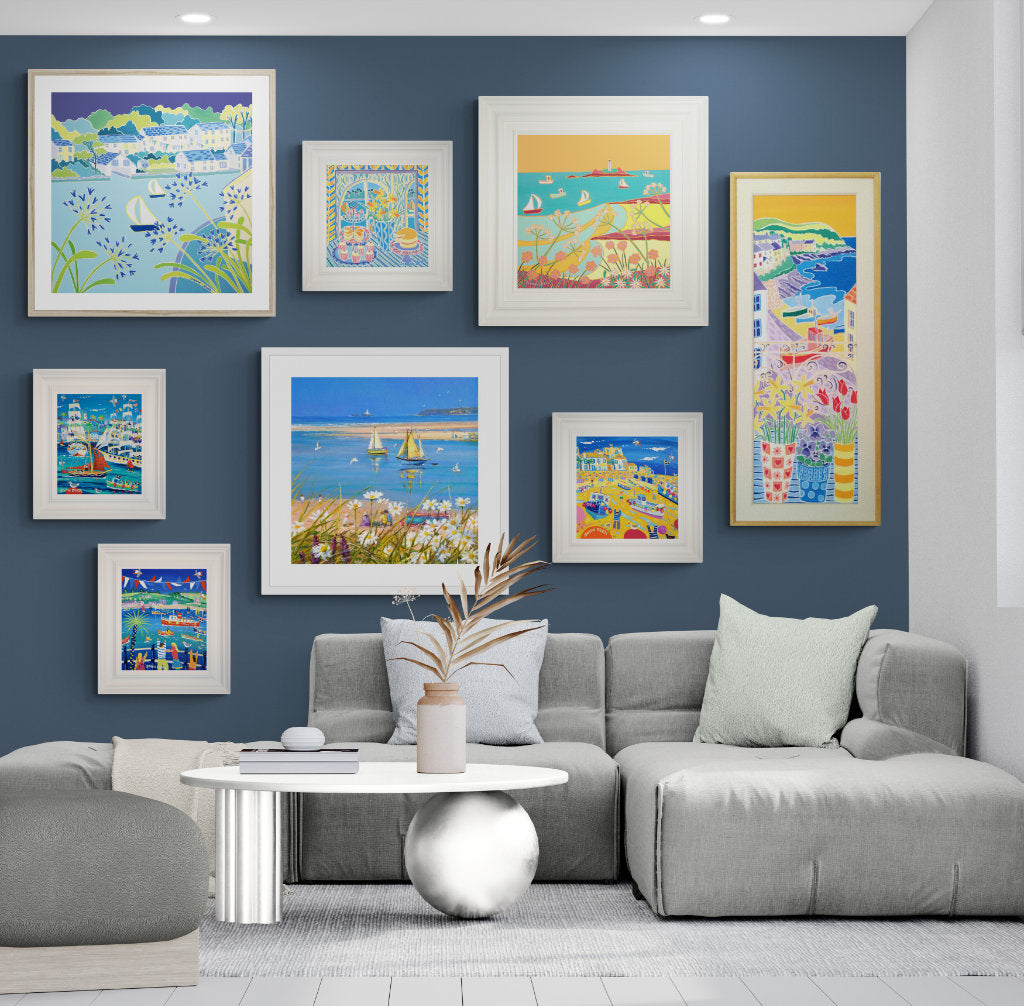
Above; An example of a room with paintings hung in 'salon' style. Paintings all courtesy of The John Dyer Gallery
Selecting artwork that mirrors your personal style is a crucial part of home decoration. The process begins by assessing your aesthetic preferences, which can be discovered through a process of self-reflection. Reflecting on past experiences, travels, and family history can help you find art that feels deeply connected to your personal memories and who you are.
Artwork that is too on-the-nose in expressing a theme can be overpowering, so aim for subtler colour palette to convey your style in a refined manner if it is tranquility that you are wanting. In the living area, consider a gallery wall to showcase an eclectic style or choose a single, large piece for a more dramatic statement that reflects your aesthetic.
In workspaces, select art that embodies personal or professional goals, while also offering inspiration and tranquillity to help alleviate stress. Remember that your personal style may evolve with time, hence it’s wise to select artworks that have the versatility to grow and adapt with your changing tastes. Posters from the John Dyer Gallery are printed to a high standard on good quality paper and are very affordable. These can then be replaced with another theme when you are ready to change the feel of your working space.
Above: Inspirational posters in an office space by cornish artist Joanne Short
Accessorise Wisely
Accessorising your space bears resemblance to adorning jewellery. It adds character and personality to your home, making it truly yours. However, it’s important to strike the right balance. Accessories should serve both a functional purpose and an aesthetic one, considering the activities of the space, such as using side tables for utility or statements that resonate with one’s style and don't clash with your artwork.
Adding personal style can be achieved with unique hand-crafted textile details and statement cushions, yet it’s essential to exercise patience and be intentional in selections to avoid a cluttered appearance. Making smart use of vertical space with items like a tall vase and choosing paintings strategically to fit in narrow spaces can enhance both the space and dynamics within a room. Joanne Short has a selection of paintings and prints that are tall and narrow.
Above: Signed Limited Edition Print by Cornish Artist Joanne Short. 'Whistling Jacks and Tall Pines, Helford Passage'
Opt for a 'less is more' approach to keep spaces uncluttered; using fewer furniture and functional items to maintain a clean aesthetic. Add a painting with a simple white frame to set off an empty wall.
Refresh Your Furniture
Furniture plays a pivotal role in home decor. It sets the tone, adds comfort, and speaks volumes about your personal style. Refreshing your furniture can significantly impact your room’s aesthetic. Here are some techniques you can use to give tired furniture new life:
-
Powder glazing
-
Decoupage
-
Distressing
-
Raised stenciling
-
Paint pouring
-
Layering
-
Paint meshing
Try out these techniques and see the transformation in your furniture!
You could also transform furniture by reupholstering; remove old fabric, replace batting and springs if needed, and apply new fabric and finishing touches for a fresh look. Additionally, a quick update to drawer pulls and cabinet handles can provide a distinctive touch and act as finishing pieces to the aesthetic of the room.
Remember you can choose paintings with particular shades to match in with your decorated furniture and wall art.
Design an Inviting Entryway
Your entryway constitutes the initial impression guests form of your home, starting with your front door. Make it count. An inviting entryway sets the tone for the rest of your home, making guests feel welcomed and at ease. Utilise hooks on walls or behind doors and build in cabinets that combine drawers, open shelves, and cabinets from floor to ceiling to offer versatile storage solutions and keep the entryway orderly.
Enhance the entryway’s functionality and inviting ambiance by:
-
Adding seating, making it more comfortable for guests and family members to prepare to enter or leave the home
-
Introducing visual interest with bold or patterned flooring
-
Using decorative paintings or prints to create a welcoming and personalised entry space that sets the tone for the rest of the home.
Curate a Stylish Bookshelf
A bookshelf serves not only as a storage unit for your books but also as a canvas for your creativity. With careful curation, a bookshelf can become a stylish focal point that reflects your personal style. This involves a diverse selection of items for your bookshelf, including books placed horizontally and vertically, interspersed with organic shaped decorative accents to add texture.
For visual appeal, here are some tips for arranging your coffee table books:
-
Pile them in odd numbers
-
Organise books by height, with taller books on the ends
-
Leave intentional empty spaces for key decorative items
-
Accentuate your book arrangement by color-coding books
-
Place books against dark or painted backgrounds to create a striking visual impact
Use your bookshelf to express your personal style by incorporating personal collections, artworks, and items that visually narrate your interests and values.
Incorporate Vintage and Antique Elements
Vintage and antique elements can imbue any space with depth and character. Combining modern bright paintings with vintage style posters can create a distinct look that allows the modern elements to shine, while the vintage style adds depth and a sense of history to the space. Ted Dyer's paintings are painted in a much more traditional style. We have a selection of original paintings and open edition prints which would look fabulous in a more traditional setting.
Above: Ted Dyer Oil Painting. Start of the Day, Flushing
Selected traditional style paintings, like those by Ted Dyer, with personal stories and nostalgic memories, provide originality and character, enabling your home to stand out with a sense of your own history and heritage. When incorporating paintings, it is crucial to respect your house’s architecture to ensure a sympathetic blend between the building’s character and the decorative elements.
Incorporating vintage rugs and earthenware accessories adds a unique charm and a grounding effect to the decor, with rugs that require less maintenance and earthenware elements that connect to natural materials.
Opt for Statement Rugs
Statement rugs can serve as the foundation of a room while incorporating an extra layer of pattern, colour, and personality. A statement rug can set the mood and tone of the room, such as evoking a bohemian feel with an Aztec design or fitting a grand or minimal-modern setting with a Persian style.
The use of texture, shape, and pattern in decor elements like rugs can create an engaging focal point that anchors the eye. Selecting the right rug can make a substantial impact, complementing the overall decor and contributing to the desired aesthetic without excess accessories.
Rugs are large-scale artworks that must be both personal and subjective, as well as hardworking, hardwearing, and practical for different living spaces. Always be careful that the rug doesnt clash with the artwork on the walls and overwhelm it.
Embrace Seasonal Decor and Artwork
Seasonal decor provides an enjoyable and rejuvenating approach to maintaining the interest and vibrancy of your home decor. As seasons change, introduce plush area rugs and throw pillows, and evoke the scent of the season with fragrances of vanilla or cinnamon during cooling weather. Pick out accent colours from the painting.
Begin with a festive mood from the entryway with a season-appropriate wreath and continue indoors with a colour palette that celebrates the time of year, such as reds and greens for Christmas, pastels for spring, or vibrant summer hues.
Accessorise your summer decor with calming blues, bold prints, and classic florals, and transition to autumn with warm tones and harvest elements like pumpkins and turning leaves. Incorporate versatile natural textures like wood and rattan that can be paired with seasonal accessories such as seashells in summer or pinecones in winter.
Make the Most of Wall Space
Despite often being overlooked in home decor, walls present abundant opportunities for expressing your style and optimising your space. Bold wallpaper can serve as a dramatic focal point in rooms that lack one, and the effect is enhanced when paired with a large painting or a striking museum style gallery wall.
Above: 'Surfing and Sunbathing, Great Western Beach, Newquay' by Cornish artist John Dyer
Floating shelves present a dual-purpose solution for decoration and storage, and they can be outfitted with baskets for hidden storage to maintain a clean look. Wall-mounted shelves use vertical space efficiently, perfect for heavy or bulky items, and can create a strong focal point when aligned or staggered strategically across a wall.
Create Cosy Nooks for Relaxation
Every home requires a cosy corner or a relaxing nook where you can unwind, read a book, or savour a cup of tea. Choose a comfortable chair with a high back and winged arms to snuggle into for the nook, and consider an ottoman or pouf as a footrest to complete the reading nook’s comfort.
Define the space of a cosy nook with a rug to anchor it without overwhelming the area, select a throw pillow for back support, and drape a colourful blanket over the chair to provide warmth and comfort. Place a stack of books in the nook to encourage reading and relaxation, keep a favourite mug close by for enjoying a hot beverage, add a scented candle to create a pleasant ambiance, and consider adding a standing swing chair or integrating elements from another room for versatility.
Organise and Display Art Collections
If displayed appropriately, your personal art collections can transform into a focal point in your home decor. Organise collection items by size, colour, or category for a neat appearance, and arrange them in groups with sufficient space between to avoid a cluttered look.
Incorporate personal connections in your display with family photographs, souvenirs, and decorative items that express your interests and passions. Utilise odd wall spaces to showcase small paintings, adding a personalised touch to your space. To ensure cleanliness and an uncluttered aesthetic, make deliberate choices about how to frame your collections and create ‘white space’ around the displayed items.
Enhance Your Ceilings
Despite often being the least considered surface in a room, ceilings possess tremendous potential for creative decor. To create a cosier atmosphere in rooms with high ceilings, painting the ceiling a darker colour can be beneficial, while avoiding strong vertical lines in the decor. Implement colour drenching by painting both the walls and the ceiling the same colour to enhance the feeling of a larger space. Pick out colours that are in your favourite paintings.
Crown molding adds classic elegance to a room, with a variety of styles available from modern to traditional. Coffered ceilings with their grid pattern of decorative beams add a luxurious touch to high ceilings. Wood beams can add warmth and character to any home style and can be crafted from reclaimed or faux wood for an aesthetic appeal without the need for structural support.
Style Your Coffee Table
A coffee table serves not only as a surface for your coffee cup but also as a platform to display your style and creativity. Starting with a foundation like:
-
book stacks
-
candles
-
sculptural objects
-
a metallic centrepiece
These ideas can create a strong base for coffee table styling.
For visual interest, layer different heights and textures using items like tall candles, thick coffee table books, and design magazines, complemented by a vase or small bowl with natural elements like fruit or flowers. Personal and playful elements, such as leaving a coffee table book open to favorite pages or integrating children’s toys that match the room’s color scheme, add a unique touch and can be conversation starters.
Maintain a clutter-free surface by using trays to corral small items, choosing minimalist elements for spacious designs, and ensuring negative space for practical use.
Upgrade Your Bedding
Your bedroom ought to serve as a haven of comfort and tranquillity. Upgrading your bedding can significantly impact the aesthetic and comfort of your bedroom.
High-quality cotton percale sheets, known for their crisp and cool feel, are commonly used in 5-star hotels and can be used to upgrade bedding at home for improved comfort and a touch of luxury.
Personalise Your Workspace
Your workspace should mirror your personality. Personalise your workspace by incorporating ergonomic furniture, such as an adjustable chair or a standing desk, to improve comfort and productivity. Utilise space-saving designs like a shelf desk under a window, a floating or fold-away desk, and hanging storage to enhance functionality in small workspaces.
Personalise the workspace with a balance of professional and personal items such as inspirational quotes, select photos, and functional decorative items like stylish lamps or storage boxes. Choose design elements like colourful artwork to reflect personal style and values, ensuring they complement the overall home aesthetic for a cohesive look.
Involve Your Kids in Decorating
Engaging your kids in decorating can provide them with a pleasurable and enriching experience. It can also lead to unique and creative decor ideas. Enable children to communicate their decorating ideas by encouraging them to create a mood board using magazine cutouts or digital platforms like Pinterest.
Review the child’s mood board with them to appreciate their selections and identify key themes such as recurring colours, patterns, or features they are attracted to. Empower the child by allowing them to select a central decor piece, like a distinct paint colour, lamp, or rug, to set the room’s overall vibe.
John Dyer's playful prints of colourful harbour scenes will set off and brighten a child's bedroom.
Above: Boats in the Harbour on a High Tide
Find innovative ways to introduce your child’s preferred decor choices, which might be unconventional, in more subtle expressions like swapping strobe lights for ambient neon or twinkle lights.
Use Mirrors to Enhance Your Space
Mirrors not only serve to reflect your image but can also considerably enhance your space. Hanging a mirror can transform a room by creating multiple reflections, enhancing perspectives, and giving an expansive and glamorous feel, especially when reflecting an original painting from across the room.
Mirrors can be strategically placed to:
-
Reflect both artificial and natural light, thereby enhancing the overall lighting and atmosphere of a room
-
Add a substantial decorative element, especially a large freestanding mirror that can be propped against a wall or featured prominently
-
Be easily shifted for varied views
Create a Cohesive Theme Throughout Your Home - Go Coastal
Establishing a unified theme across your home can help bring together different spaces and foster a harmonious ambiance. Choosing a foundational colour palette, such as shades of green and terracotta, and using a consistent trim colour like white throughout the house can promote a cohesive atmosphere.
Above: Summer Sunset, Bedruthan Steps, Cornwall by Joanne Short
An accent colour can be used consistently across various rooms to maintain continuity and link different spaces together, while allowing for occasional pops of colour. Selecting a specific style, such as nautical or seascape, and using shared materials or consistent accent pieces helps to establish a theme that can be carried through all rooms in the home. Add ornaments in driftwood or colourful wooden boats to compliment the paintings.
Utilising a mood board to visualise aesthetic preferences and the elements of interior design can aid in developing a coherent decorating strategy.
Add Personality with Unique Accents and Artworks
Infusing your space with personality involves incorporating unique accents and decorative objects, creating an inviting space. Home decor should showcase personal interests, such as music or photography, through art and objects representative of these passions.
Mushroom-shaped lights, vibrant accent chairs, and the use of colourful prints as pops of colour on the walls can make the decor stand out and reflect a bold and joyous character. Striking personal statements can be made by painting window frames, reveals, and shutters in the accent colour you love most, and opting for bright, jewel-toned walls to pick out the colours in your artwork.
Umbrella stands in materials like woven wicker, along with creatively repurposing an old chair or suitcase as furniture, can add function and charm, while making use of unique room features such as a stained glass window adds a personal touch.
Invest in Quality Prints, Posters and Original Paintings
Investment in quality prints and original paintings offers a splendid approach to enhance your home decor. Original paintings and good quality prints on museum quality paper can prevent the frequent need to replace faded images saving costs over time due to their durability and longevity. Quality prints offer visual appeal of a space with its superior design aesthetics.
Here at The John Dyer Gallery we are proud of the quality of our signed limited edition prints and posters. Describing them, artist John Dyer says:
"Our posters are museum-quality and can last 100+ years in ideal conditions. The paper is a fine art paper, and the inks are vibrant. We are sure you will be impressed. The term 'poster' only refers to the vintage-style design with the typography as the quality is 100% fine-art archival quality that can last for generations."
Choosing meticulously crafted furniture and paintings from skilled artisans using premium materials will also offer several benefits:
-
Better long-term financial value
-
Quality usage and attractive resale opportunities
-
Commissioned pieces, painted especially for you
-
Excellent customer service
All of these factors contribute to greater personal satisfaction and well-being.
Stay True to Your Personal Style
Remaining faithful to your personal style is potentially the most important aspect of home decor. To stay true to one’s personal style, it’s crucial to:
-
Engage in self-reflection to understand unique aesthetic preferences
-
Be honest about what feels right rather than following trends
-
Utilise tools such as mood boards and discussions with designers to facilitate the expression of personal style
-
Ensure home decor is a reflection of one’s lifestyle and preferences
Incorporating a theme into home decor should be done with subtlety to create a timeless look that speaks to personal style without appearing kitschy. While a home should have a cohesive core design, each room can express variations of personal style, giving them distinct personalities.
Summary
We’ve journeyed through a myriad of inspired ideas to decorate your home, transforming your space with art, patterns, textures, and more. We’ve discussed the importance of incorporating nature into decor, creating focal points, optimising lighting, personalising your space with DIY projects, and maximising small spaces.
We’ve touched upon the significance of experimenting with colour, choosing artwork that reflects your style, updating window treatments, accessorising wisely, refreshing furniture, designing an inviting entryway, curating a stylish bookshelf, transforming your outdoor space, and incorporating vintage and antique elements.
We’ve also delved into the importance of statement rugs, embracing seasonal decor, making the most of wall space, creating cosy nooks for relaxation, organising and displaying collections, enhancing ceilings, styling your coffee table, upgrading your bedding, and designing functional storage solutions. And we’ve stressed the importance of personalising your workspace, reimagining unused spaces, involving your kids in decorating, using mirrors to enhance your space, creating a cohesive theme throughout your home, adding personality with unique accents and artworks, planning your space with function in mind, maintaining a balance between form and function, investing in quality pieces and original paintings, and staying true to your personal style.
As you embark on your home transformation journey, remember that your home decor should be a reflection of you. It should tell your story, express your personality, and resonate with your lifestyle.
Frequently Asked Questions
How can I decorate my house nicely?
To decorate your house nicely, you can start by painting a colourful front door, giving every room a focal point, layering your lighting, adding houseplants, using mirrors strategically, mixing and matching furniture, combining different textures, and upsizing your artwork. These tips will help you create a professionally designed and visually appealing space.
How do I start decorating my house?
To start decorating your house, giving every room a focal point through its artwork, consider your lighting, adding houseplants, strategically using mirrors, mixing and matching furniture, combining different textures, and upsizing your artwork. Get creative and enjoy the process!
How can I incorporate nature into my decor?
You can incorporate nature into your decor by adding indoor plants, using natural materials like raw woods and fibres, and hanging art prints that feature the beauty of nature. Embracing nature in your decor brings a sense of tranquility and connection to the outdoors. Try introducing paintings that include flowers and foliage in their composition.
What are some tips for optimizing lighting in a room?
To optimise lighting in a room, create a balanced lighting scheme by layering and accent lighting to accommodate various activities and enhance the space's aesthetics. This can be especially beneficial for specific areas such as dining rooms and kitchens. Start transforming your space with these lighting tips.
How can I personalise my workspace?
To personalise your workspace, incorporate ergonomic furniture, space-saving designs, and a mix of professional and personal items. Choose design elements like colour and artwork that reflect your personal style.








